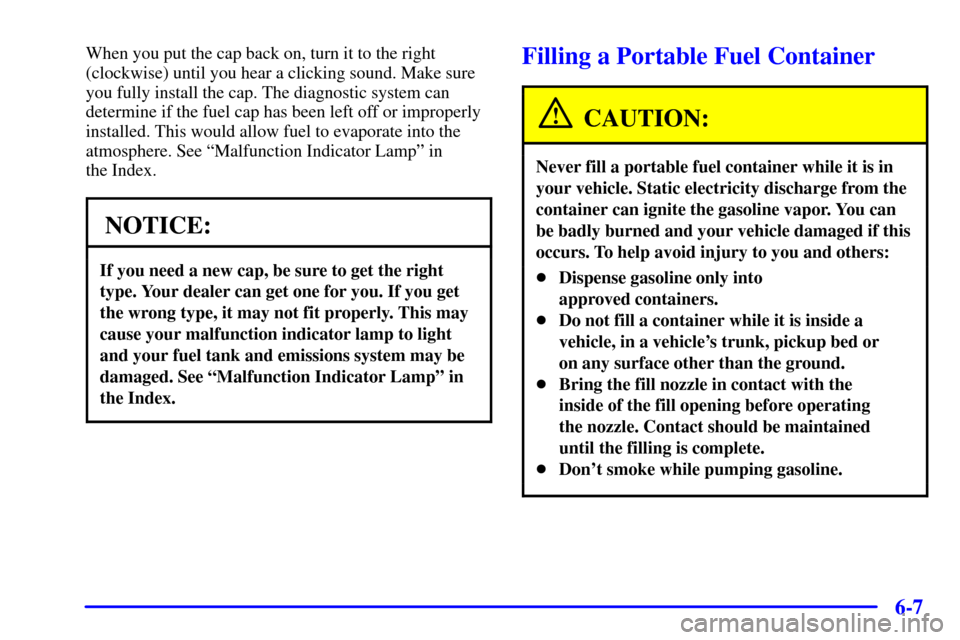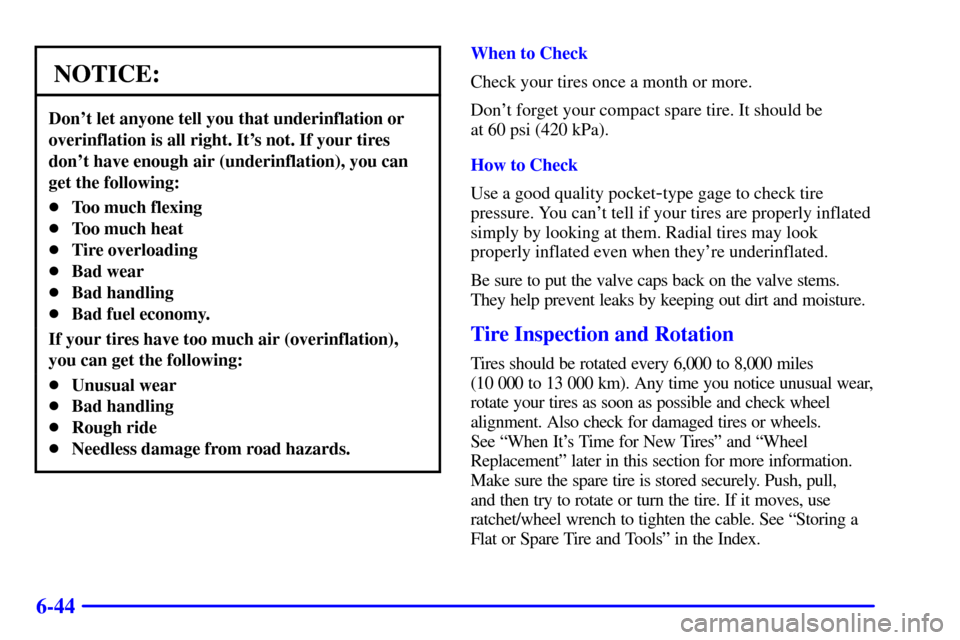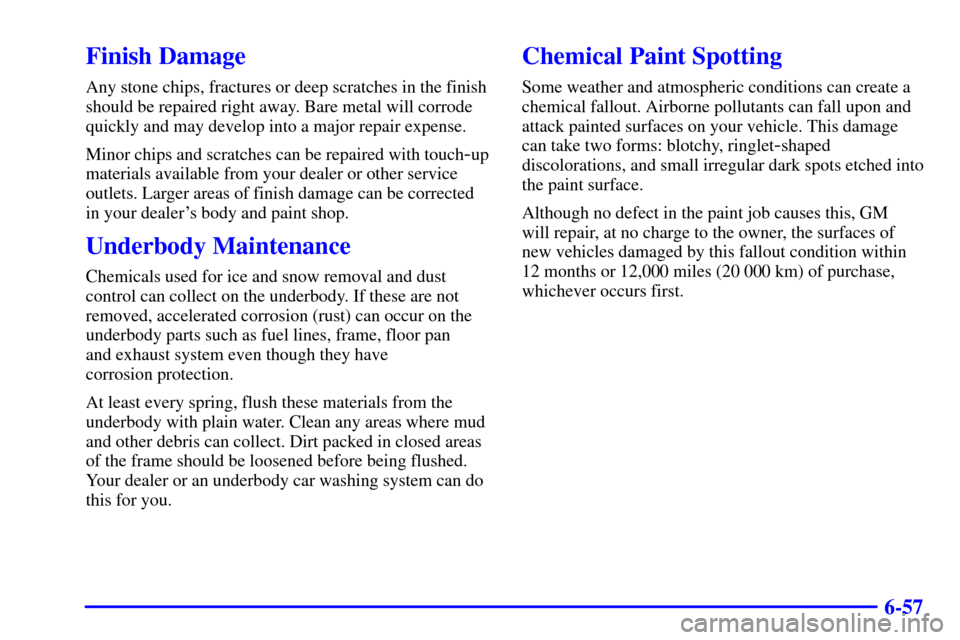Page 258 of 388
6-6
To remove the cap, turn it slowly to the left
(counterclockwise). The cap has a spring in it; if you let
go of the cap too soon, it will spring back to the right.
CAUTION:
If you get gasoline on yourself and then
something ignites it, you could be badly burned.
Gasoline can spray out on you if you open the
fuel filler cap too quickly. This spray can happen
if your tank is nearly full, and is more likely in
hot weather. Open the fuel filler cap slowly and
wait for any ªhissº noise to stop. Then unscrew
the cap all the way.
Be careful not to spill gasoline. Clean gasoline from
painted surfaces as soon as possible. See ªCleaning the
Outside of Your Vehicleº in the Index.
Page 259 of 388

6-7
When you put the cap back on, turn it to the right
(clockwise) until you hear a clicking sound. Make sure
you fully install the cap. The diagnostic system can
determine if the fuel cap has been left off or improperly
installed. This would allow fuel to evaporate into the
atmosphere. See ªMalfunction Indicator Lampº in
the Index.
NOTICE:
If you need a new cap, be sure to get the right
type. Your dealer can get one for you. If you get
the wrong type, it may not fit properly. This may
cause your malfunction indicator lamp to light
and your fuel tank and emissions system may be
damaged. See ªMalfunction Indicator Lampº in
the Index.
Filling a Portable Fuel Container
CAUTION:
Never fill a portable fuel container while it is in
your vehicle. Static electricity discharge from the
container can ignite the gasoline vapor. You can
be badly burned and your vehicle damaged if this
occurs. To help avoid injury to you and others:
�Dispense gasoline only into
approved containers.
�Do not fill a container while it is inside a
vehicle, in a vehicle's trunk, pickup bed or
on any surface other than the ground.
�Bring the fill nozzle in contact with the
inside of the fill opening before operating
the nozzle. Contact should be maintained
until the filling is complete.
�Don't smoke while pumping gasoline.
Page 260 of 388
6-8
Checking Things Under the Hood
CAUTION:
Things that burn can get on hot engine parts and
start a fire. These include liquids like fuel, oil,
coolant, brake fluid, windshield washer and other
fluids, and plastic or rubber. You or others could
be burned. Be careful not to drop or spill things
that will burn onto a hot engine.
Hood Release
To open the hood, first pull the handle located inside the
vehicle on the lower driver's side of the kick panel.
Page 263 of 388
6-11
Before closing the hood, be sure all the filler caps are on
properly. Then lift the hood to relieve pressure on the
hood prop.
Remove the hood prop
from the slot in the hood
and return the prop to
its retainer.
Then just pull the hood down and close it firmly.
Engine Oil
Checking Engine Oil
It's a good idea to check your engine oil every time you
get fuel. In order to get an accurate reading, the oil must
be warm and the vehicle must be on level ground.
The engine oil dipstick has a yellow ring and is located
near the center of the engine compartment. See ªEngine
Compartment Overviewº in the Index for more
information on location.
Page 296 of 388

6-44
NOTICE:
Don't let anyone tell you that underinflation or
overinflation is all right. It's not. If your tires
don't have enough air (underinflation), you can
get the following:
�Too much flexing
�Too much heat
�Tire overloading
�Bad wear
�Bad handling
�Bad fuel economy.
If your tires have too much air (overinflation),
you can get the following:
�Unusual wear
�Bad handling
�Rough ride
�Needless damage from road hazards.
When to Check
Check your tires once a month or more.
Don't forget your compact spare tire. It should be
at 60 psi (420 kPa).
How to Check
Use a good quality pocket
-type gage to check tire
pressure. You can't tell if your tires are properly inflated
simply by looking at them. Radial tires may look
properly inflated even when they're underinflated.
Be sure to put the valve caps back on the valve stems.
They help prevent leaks by keeping out dirt and moisture.
Tire Inspection and Rotation
Tires should be rotated every 6,000 to 8,000 miles
(10 000 to 13 000 km). Any time you notice unusual wear,
rotate your tires as soon as possible and check wheel
alignment. Also check for damaged tires or wheels.
See ªWhen It's Time for New Tiresº and ªWheel
Replacementº later in this section for more information.
Make sure the spare tire is stored securely. Push, pull,
and then try to rotate or turn the tire. If it moves, use
ratchet/wheel wrench to tighten the cable. See ªStoring a
Flat or Spare Tire and Toolsº in the Index.
Page 309 of 388

6-57
Finish Damage
Any stone chips, fractures or deep scratches in the finish
should be repaired right away. Bare metal will corrode
quickly and may develop into a major repair expense.
Minor chips and scratches can be repaired with touch
-up
materials available from your dealer or other service
outlets. Larger areas of finish damage can be corrected
in your dealer's body and paint shop.
Underbody Maintenance
Chemicals used for ice and snow removal and dust
control can collect on the underbody. If these are not
removed, accelerated corrosion (rust) can occur on the
underbody parts such as fuel lines, frame, floor pan
and exhaust system even though they have
corrosion protection.
At least every spring, flush these materials from the
underbody with plain water. Clean any areas where mud
and other debris can collect. Dirt packed in closed areas
of the frame should be loosened before being flushed.
Your dealer or an underbody car washing system can do
this for you.
Chemical Paint Spotting
Some weather and atmospheric conditions can create a
chemical fallout. Airborne pollutants can fall upon and
attack painted surfaces on your vehicle. This damage
can take two forms: blotchy, ringlet
-shaped
discolorations, and small irregular dark spots etched into
the paint surface.
Although no defect in the paint job causes this, GM
will repair, at no charge to the owner, the surfaces of
new vehicles damaged by this fallout condition within
12 months or 12,000 miles (20 000 km) of purchase,
whichever occurs first.
Page 317 of 388
6-65
Feed Usage
AUX B Upfitter Battery Feed
AUX A Upfitter Accessory FeedRelay Usage
A/C Relay Rear Heat and Air Conditioning
Upfitter
-ACCY
RelayUpfitter Accessory
Starter
Enable RelayStarter
A/C
Enable RelayAir Conditioning
Headlamps
RelayHeadlamps
Fuel Pump Relay Fuel Pump
Fuse/Circuit
BreakerUsage
UPFITTER
-
BATTUpfitter Battery Power Stud,
Trailer Wiring Harness
UPFITTER
-
ACCYUpfitter Accessory Relay
Spare Not used
Spare Not used
Spare Not used
ECM
-1B Fuel Pump Relay and Motor,
VCM, Oil Pressure Switch/Sender
Page 318 of 388
6-66
Fuse/Circuit
BreakerUsage
HORN Horn Relay and Horn
A/C COMP A/C Enable Relay and Compressor
RR HTR/AC Rear Heater and A/C
ATC Active Transfer Case
-L Van
FRT HVAC Front Heater and A/C
ENG
-I Oxygen Sensors, Camshaft
Position Sensor, Mass Air Flow
Sensor, Evaporative Emission
Canister Vent Solenoid
IGN
-E A/C Enable Relay Coil
ECM
-I Fuel Injectors 1-6, Crankshaft
Position Sensor, VCM, Coil
Driver Module (EST),
Ignition Coil
Blank Not Used
RH HDLMP Right Headlamp
LH Headlamp Left HeadlampFuse/Circuit
BreakerUsage
Blank Not Used
Blank Not Used
DIODE
-1 A/C
Blank Not Used
Blank Not Used
Blank Not Used
LIGHTING Courtesy Fuse, Pwr. Adj. Mirrors
Fuse, TBC
-Battery Fuse
BATT Power ACCY CB, Stop/Hazard
Fuse, Auxiliary Power Fuse,
Cigarette Lighter Fuse, Radio
Battery Fuse
IGN A Starter Relay, Ignition Switch
IGN B Ignition Switch
ABS Electronic Brake Control Module
Blank Not Used
RAP Radio Accy, Power Windows
HTD MIR/RR
DEFOGRear Window Defogger, HVAC
Control Head